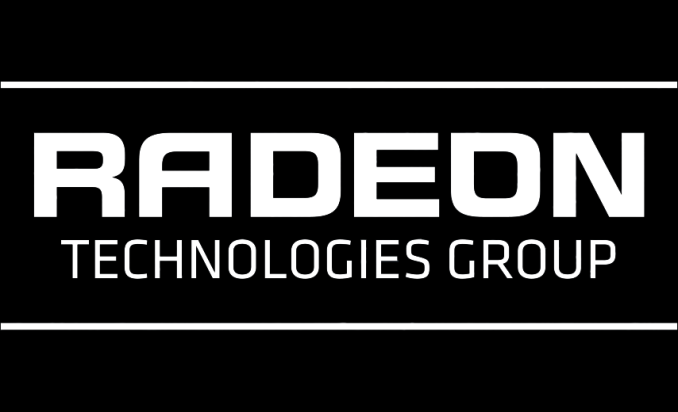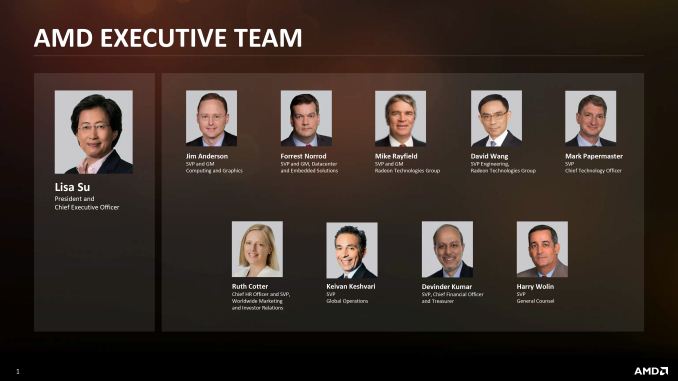AMD Reassembles the Radeon Technologies Group: New Leadership Hired & Semi-Custom Folded Into RTG
by Ryan Smith on January 23, 2018 5:00 PM EST- Posted in
- GPUs
- AMD
- Radeon
- Radeon Technologies Group

Ever since Raja Koduri abdicated his leadership post at AMD’s Radeon Technologies Group in favor of a similar post at Intel, the big question on everyone’s mind has been what would become of the RTG and who would lead it. While AMD – and ATI before it – is far from a stranger to graphics, the formation of the RTG in 2015 marked an important point in the development of AMD’s graphics business, as it was finally re-made whole under the AMD umbrella. As a business-within-a-business, RTG was largely seen as Raja’s baby, so his departure was destined to have a large impact.
Now just a bit over two months later, we finally know the fate of RTG. Today AMD is announcing the new leadership for RTG, bringing on two new Senior Vice Presidents to run the division. Meanwhile the company is also making some organizational changes to RTG, which although will keep RTG intact as a singular entity, will see it internally organized into dedicated engineering and business teams, each in turn reporting to their respective SVP heads. This change means that RTG doesn’t have a true, singular leader – not that Raja had full overview over RTG’s business operations, I’m being told – but rather both of the new SVPs report to AMD’s CEO, Dr. Lisa Su, and together represent the business unit.
Finally, while in the process of reorganizing and rebuilding the leadership of the RTG, AMD is announcing that they have also reassigned the semi-custom business unit. Semi-custom is now being folded into the business side of RTG, and while AMD’s announcement doesn’t note that there are any changes in how the semi-custom unit will operate, it will fall under the purview of the head of RTG’s business group.
RTG Engineering Group Leadership: David Wang, Senior Vice President of Engineering
First off then, let’s talk about the engineering side. The new head of RTG’s engineering efforts (and arguably the de-facto successor to Raja) will be David Wang. Wang is a name that some long-time followers may be familiar with, as until earlier this decade he was a long-term AMD employee that rose through the ranks to become a Corporate Vice President of AMD’s GPU and SoC efforts. And as you might expect for someone hired for AMD’s top GPU engineering post, Wang has a long history in the graphics industry, working for SGI before joining ArtX and going through the ArtX-to-ATI-to-AMD acquisition chain. Specific to his experience at AMD, Wang has worked on every AMD GPU between the R300 and the Southern Islands (GCN 1.0) family, so he’s seen the full spectrum over at AMD.
More recently, he’s been serving as the Senior VP of Synaptics, where he was one of several former ATI/AMD employees to jump ship over there around the turn of the decade. So for David Wang, in a sense this is coming back home to AMD. Which off the top of my head makes him the third such high profile engineer to jump out and back in over the last decade, after Raja Koduri and CPU guru Jim Keller.
Wang re-joins AMD at a critical time for its engineering group. With the Vega launch behind it, RTG’s engineering staff is in the middle of development of the Navi GPU architecture and beyond, all the while putting the finishing touches on Vega Mobile for this year and squeezing in a 7nm Vega design for servers for 2019. Vega’s launch has been a contentious one – for engineering reasons as much or more so than business reasons – so Wang may very well be a much-needed breath of fresh air for RTG’s engineering teams.
Officially, AMD is stating that in his position, Wang will be responsible for “graphics engineering, including technical strategy, architecture, hardware and software for AMD graphics products,” the last item in particular being notable, as this confirms that software is staying under the control of the engineering group rather than being more distributed through AMD as it once was.
RTG Business Group Leadership: Mike Rayfield, Senior Vice President and General Manager
David Wang’s counterpart on the business side of matters will be Mike Rayfield, who is being tapped to serve as the Senior VP and the General Manager of the business group. Rayfield is another industry veteran, albeit one without the same immense GPU history of Wang. Instead Rayfield’s history includes posts such as the VP and General Manager of NVIDIA’s mobile business unit (Tegra) and a director of business development at Cisco. Most recently (and for the past 5 years), Rayfield has been at Micron serving as the memory manufacturer’s VP and GM for their mobile business unit, which houses Micron’s mobile-focused memory and storage product groups.
AMD notes that Rayfield has “30 years of technology industry experience, including a deep understanding of how to grow a business and drive results,” which says a lot about AMD’s direction in very few words. Instead of hiring another GPU insider for the post, AMD is bringing in someone from outside the industry altogether, someone who has plenty of experience with managing a growing business. RTG’s business struggles are of course well-known at this point, so this offers AMD the chance to reset matters and to try to fully righten the conflicted business unit.
Rayfield is definitely joining RTG and AMD at an interesting time. On the business side of matters RTG is contending with the fact that Vega (and practically every other GPU AMD makes) is proving incredibly popular with cryptocurrency mining groups, to the point that, above the entry-level market, the North American consumer market has been entirely depleted of AMD-based video cards. In the short term this means that AMD is selling everything they can make, but Rayfield will have to help AMD grapple with the long-term effects of this shift, and how to keep the newly minted mining customers happy without further losing disillusioned gaming customers.
AMD Semi-Custom Folded Into RTG
Meanwhile along with overseeing the traditional business aspects of the GPU group, Rayfield is also inheriting a second job, overseeing AMD’s semi-custom business unit. Previously a part of the Enterprise & Embedded unit, semi-custom is being moved under the business side of RTG, putting it under Rayfield’s control. This reorganization, in turn, will see the Enterprise & Embedded unit separated from semi-custom to become the new Datacenter and Embedded Solutions Business Group, which will continue to be operated by SVP and GM Forrest Norrod.
Truth be told I’m still not 100% sure what to make of this change. AMD’s semi-custom focus was a big deal a few years back, and while the business has done well for itself, the focus at the company seems to have shifted back to selling processors directly, built on the back of the technological and sales success of the Zen architecture and its derivative products. Meanwhile, AMD is citing the fact that graphics is a core part of semi-custom designs as the rationale for putting it under the RTG. AMD still believes that the semi-custom business is more than just providing processors to the game console industry, but I do think that after a few years of pursuing this route, that this is the realization that game consoles are going to remain the predominant semi-custom customer. So in this respect it’s a bit of a return to status quo: game consoles are now once again part of the graphics business. And in the meantime semi-custom has certainly become a lower priority for AMD, as it’s a very regular in volume but relatively low in gross margin business for the company compared to their increasing CPU fortunes.
Finally, speaking of finances, it’s worth noting that AMD is calling this an increase in the company’s investment in RTG. The company isn’t throwing around any hard numbers right now, but it sounds like overall the RTG budget has been increased. AMD has of course struggled mightily in this area as a consequence of their lean years – in particular, it seems like AMD can’t complete as many GPU die designs per year as they once did – so combined with the shift in leadership, I’m optimistic that this means that we’re going to see AMD shift to an even more competitive position in the GPU marketplace.
Source: AMD













50 Comments
View All Comments
tuxRoller - Wednesday, January 24, 2018 - link
Yup! That's been my impression for awhile now. For whatever reason people just couldn't shake the idea that anything could be better than a gpu.They remain the best solution that is easily available but they have far too much complexity that just does nothing for these problems.
TheJian - Tuesday, January 23, 2018 - link
We can blame management for repeatedly wasting R&D on things that don't max profit margins! Almost all of the money is made above $200 (cpu or gpu). Designing for low margin crap is dumb and should only come later or as a way to use bad chips etc.RandSec - Tuesday, January 23, 2018 - link
It is easy to sniff at Semicustom margins, but remember that the customers have paid for almost all of the engineering in those chips (albeit based on existing AMD IP). Since AMD has little invested, they get a good Return On Investment from Semicustom, even with low production margins.In the future, the expansion of chiplet-based Multi-Chip Module products could lead to a renaissance in the Semicustom business, since customers may not need to design an entire huge chip on their own.
mode_13h - Tuesday, January 23, 2018 - link
It seems like they also get the benefit of very close collaboration with MS and Sony, which no doubt guides and influences their hardware architecture decisions. I remember reading about features of the PS4 and XBox One GPUs that were specifically requested, which would later be reflected in their mainstream GPUs.TheJian - Tuesday, January 23, 2018 - link
Consider me sniffing and puking on those margins. If you aren't MAXIMIZING profits from your product you're wasting your engineering. PERIOD.See AMD went low on gpu - NV went high (1080/1070 etc). NV didn't even bother with the low end until high end slows (and it really hasn't...LOL, they just had time to make cheaper stuff now). Never produce for the poor first, you will FAIL. You might be able to find the odd one out that breaks that rule, but as a rule if you aren't targeting people with fat wallets first, you've already made a mistake.
See Q reports for both sides for ages (check Intel too). Dirk said it when they fired him. PRODUCE A KING FIRST, or die. Funny they tried to follow his advice 5yrs too late, after firing him for saying it...ROFL. APU/custom was a complete waste of R&D that could have kept them in both the CPU race for real, and not keep getting killed on watts/heat/bad launches etc on the gpu side. Even the cpu side sucked at launch for brand new ryzen chips (should have waited for board crap/mem stuff to work out etc). A few months more baking ryzen boards would have changed reviews from "well...maybe for some people" to something more like "pretty darn great". Review after review mentioned the problems. You usually only get one chance at a first impression ;)
AMD's dumb pricing is another issue. Price for max you can get or you're fired (especially when you're the smaller guy - make hay...). You are not in business to be our friend...LOL. If you produce a winner people buy it even if it stings.
Manch - Tuesday, January 23, 2018 - link
I think that the semicustom is actual great for RTG. They have their chips in both the Sony & MS platforms and the way consoles are going we will just see more versions of the "same" platform ie pro, X. I dont see either jumping ship to Intel or Nvidia. Certainly not MS.mode_13h - Tuesday, January 23, 2018 - link
Why "Certainly not MS"? Is there bad blood between them and Nvidia or Intel?Makaveli - Tuesday, January 23, 2018 - link
I believe MS and Nvidia had some beef over the first xbox back in the day.Manch - Wednesday, January 24, 2018 - link
Yeah, MS wanted to continue to make the XBOX but bc they used off the shelf parts from NVidia and Intel, both companies refused to keep making them. So MS decided that its next console would use a semi custom design that they "own"mikato - Sunday, January 28, 2018 - link
Ha, they stopped making the parts that MS was buying and putting into the XBoxes. That’s rich. Way to alienate a customer, one that could be a good long term customer. AMD reaps the benefits by catering to the customer, and is a better fit with their APUs to begin with.